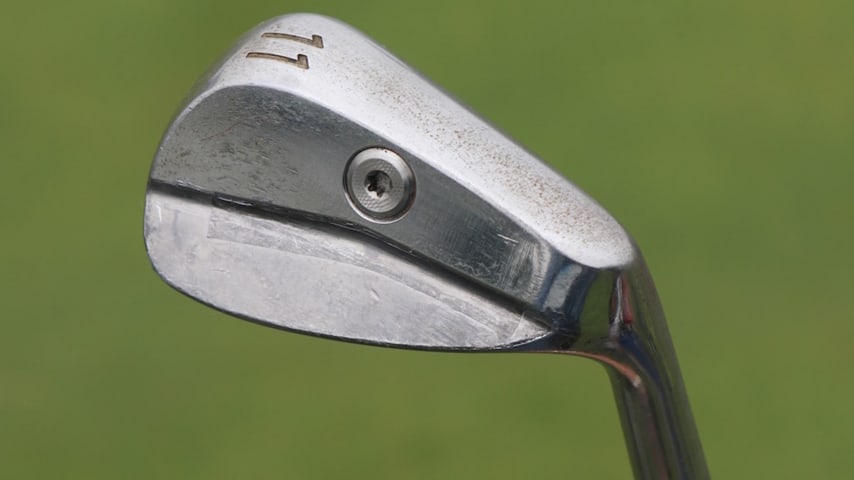Maverick McNealy’s rare '11 iron' and Callaway prototype blades
4 Min Read

Written by GolfWRX
For more than a year now, Callaway staffer Maverick McNealy has been working closely with the Callaway design team to craft an entirely new set of prototype irons made just for him. It’s been a long time coming, but the set is nearly complete and ready for competition at the 2022 Charles Schwab Challenge at Colonial Country Club.
Fresh out of Stanford University, McNealy turned professional in 2017 and signed with Callaway Golf. The former No. 1-ranked amateur was a highly sought after recruit for the major OEMs, although he’d been playing Nike irons for most of his life.
Throughout his professional career so far, as a Callaway staffer, McNealy has bounced back and forth between a set of Nike VR Pro blade irons and Callaway Apex MB (muscleback) irons. In 2022, though, McNealy has mostly opted for the Nike set.
It’s not that McNealy doesn’t like Callaway’s iron products, it’s that he is used to a certain look, shape and center of gravity location that triggers his release point at impact. He prefers a longer heel-to-toe length, which is different than the more compact modern day blade offerings that most pros use these days.
With this in mind, McNealy and Tim Reed (the Senior VP of Global Sports Marketing at Callaway) got to work over a year ago on a completely new Callaway set that would fit McNealy’s discerning eye and performance needs.
At the 2022 AT&T Byron Nelson a few weeks ago, McNealy finally unveiled part of the set (4-7 iron), and GolfWRX.com caught up with McNealy to get his explanation.
“So, this process started just over a year ago, and I’ve been working really closely with Tim Reed on this,” McNealy told GoflWRX. “It’s really trying to fill a gap in the performance blade market, which there really isn’t anything with that much length heel to toe and a center of gravity far enough from the hosel.
“For me…getting that center of gravity further away from the hosel gives me more club head awareness on the way down. It slows down the closure rate and keeps the club face square longer. I found out with other blades, because they’re so short heel to toe, and the center of gravity is so close to the heel, that I was shutting them down too fast for me. So these help keep the club face square on the way back and give me that awareness on the way through.”
For Reed and McNealy, the iron developing and testing process has been nothing short of thorough. McNealy has exacting wants and needs, and they’re leaving no stone unturned.
“We’re measuring offsets, impact height, location, lead groove height, there’s just so many little details that change the way you deliver the club, the way you feel it,” McNealy said. “The next thing we’re looking at is making sure every iron is spinning exactly the way we want through the bag especially with the new golf ball, the prototype [Chrome Soft X] golf ball that I’ve been playing from Callaway, which is awesome.”
At the 2022 Byron Nelson, McNealy used the new Callaway Apex MB prototype irons in the upper portion of his set (4-7), but he continued using his Nike VR Pro irons in the bottom half (8-PW). He needed more time to dial in the short irons.
This week, at the 2022 Charles Schwab Challenge, McNealy is ready with nearly the full set, which includes 4-9 irons, and a 10- and 11-iron; the “10 iron” replaces his Nike pitching wedge, and the “11 iron” replaces his former Callaway gap wedge.
Why the 10 and 11 irons? Well, McNealy says he wanted his iron set to flow smoothly into his wedges. He doesn’t use a pitching wedge or a gap wedge to chip around the greens, so he wanted those clubs to resemble the look and performance of his irons, rather than traditional wedges.
“The 10 and 11 iron is a fun project for us because I almost never chip with a pitching wedge or gap wedge, and if I do it’s a bump and run, so I just want something that’s going to flow straight through from my short irons to my approach irons, or however you want to call them,” McNealy told GolfWRX. “I’ve seen them launch lower with a little bit more spin, which is great for distance control, and they feel just like my irons, which is a pretty exciting project.”
Compared to the 4-9 irons, which have 17 narrowly spaced grooves on their faces, the 10 and 11 irons have just 14 grooves that are more widely spaced. The groove configuration in the 10 and 11 irons help provide McNealy with the lower launch and greater spin that provides more control in the shorter clubs.
This week at the 2022 Charles Schwab Challenge, the set is nearly complete; McNealy and Callaway are now just working to fine-tune the 3-iron, which the lone Nike VR Pro iron left in his bag setup.
More than a year after starting the project, they’re almost at the finish line.







